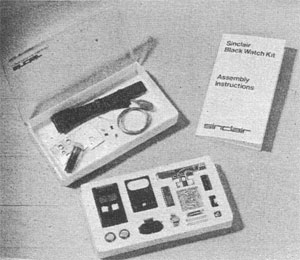|
The Black Watch
Sinclair Radionics, 1975
Exactly
a decade before the C5
fiasco, Sinclair was nearly brought down by another disastrous
product - the Black Watch, launched in September 1975
at £17.95 in kit form and £24.95 ready-built.
Its name was uncharacteristically descriptive by Sinclair's
usual standards - virtually every other Sinclair product had
an arbitrary, often made-up name or jumble of letters and
numbers attached to it. In fact, it is actually a pun; the
original Black Watch was a famous Scottish army unit.
Sinclair's
Black Watch was a unconventional-looking digital watch, moulded
in black plastic with a five-digit LED display. Its most unusual
feature was its lack of buttons or, indeed, a consistent display.
To conserve power, the display defaulted to being turned off.
Immediately below were two panels which
turned on the display and allowed you to see hours and minutes
or minutes and seconds, depending on which you pressed. The
adverts rather obscurely described it as having "a touch
and see case" with "no unprofessional buttons".
It actually came in three versions, in grey as well as the
nominal black, with the more sophisticated grey version also
displaying the date.
The Black Watch was a commercial and technical
disaster from the start. The list of problems is long and
depressing:
- The chip could be ruined by static from
your nylon shirt, nylon carpets or air-conditioned office.
This problem also affected the production facility, leading
to a large number of failures before the watches even left
the factory. The result was that the display would freeze
on one very bright digit, causing the batteries to overload
(and occasionally explode). This fragility has meant that
very few working Black Watches survive today.
- The accuracy of the quartz timing crystal
was highly temperature-sensitive: the watch ran at different
speeds in winter and summer.
- The batteries had a life of just ten
days; this meant that customers often received a Black Watch
with dead batteries inside. The design of the circuitry
and case made them very difficult to replace.
- The control panels frequently malfunctioned,
making it impossible to turn the display on or, alternatively,
impossible to turn it off - which again led to exploding
batteries.
- The kit was almost impossible for hobbyists
to construct (and barely any easier for Sinclair's hard-pressed
workforce). Practical Wireless advised readers to
use two wooden clothes pegs, two drawing pins and a piece
of insulated wire to work the batteries into position. You
then had to spend another four days adjusting the trimmer
to ensure that the watch was running at the right speed.
- The casing was very hard to keep in one
piece. It was made from a plastic which turned out to be
unglueable, so the parts were designed to clip together.
The clips didn't work either and the problem was turned
over to a subcontractor. Sinclair later (much later) received
a small box on which was written, "We've solved the
problem of the Black Watch!". Inside was a Black Watch
with a half-inch bolt driven though it.
 The
Black Watch's catalogue of problems led to a very high percentage
being returned, leading to the legend that Sinclair actually
had more returned than had been manufactured. The company
had to go through the business of sending out tens of thousands
of replacements, with no financial benefit whatsoever. Matters
were made far worse by the perennial lack of a customer services
department - only 20 people were available to repair and return
all the faulty watches. The backlog eventually reached such
monstrous proportions that it still hadn't been cleared two
years later. The
Black Watch's catalogue of problems led to a very high percentage
being returned, leading to the legend that Sinclair actually
had more returned than had been manufactured. The company
had to go through the business of sending out tens of thousands
of replacements, with no financial benefit whatsoever. Matters
were made far worse by the perennial lack of a customer services
department - only 20 people were available to repair and return
all the faulty watches. The backlog eventually reached such
monstrous proportions that it still hadn't been cleared two
years later.
The Black Watch fiasco had a devastating
effect on Sinclair's finances: the company made a loss of
£355,000 for 1975-6 on a turnover of £5.6m. The
company would have gone bankrupt had not the Government, in
the shape of the National Economic Board, stepped in to prop
it up with subsidies and, eventually, direct management. Sinclair
seems to have accepted state involvement only grudgingly and
plainly did not enjoy the experience. In the 1980s, Margaret
Thatcher's government - of which Sinclair was an ardent supporter
and from which he gained his knighthood - abolished the NEB.
Although Sinclair very probably approved of this on ideological
grounds, the NEB's demise removed his safety net. The next
time his company tottered under the strain of another disastrously
botched product (in this case, the C5),
Sinclair had no option but to sell it to an arch-rival, Amstrad.

Back
to top
© Chris Owen 1994-2003
|